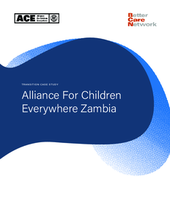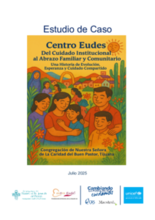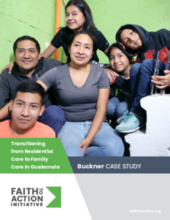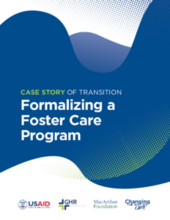The aim of this stage is to explore what types of services and/or programs the organisation could offer instead of institutional care and begin the process of designing the new services.
The aim of the exploration aspect of this stage is about looking at a range of factors that should influence the decision-making about what services to develop. Stage. The design component of this stage is about developing the concept for the new services.
This stage should ideally involve relevant stakeholders in a co-design process, including children and families (end-users) and local community/community leaders. It is also about making sure new services sare designed to be rights-based and take into account core principles of sustainability, strengths and empowerment.
This stage is concerned with scoping for ideas, the evaluation of options and the process of designing new services or programs.
Factors that should be explored in this stage, and which should influence decisions about post transition services or programs, include:
- Gaps in existing services available to children and families across the child protection (including alternative care services), child and family welfare, social protection and in some cases education systems. This could be gaps in services in the local area where the organisation is operating, gaps in the local areas where children may return to, or gaps at the national/systems level.
- Government plans and priorities for new services which might include new standards, guidelines, regulations and/or the prioritization of certain geographical areas or types of services.
- The organization’s strengths, weakness and opportunities.
- The likely types of supports children and their families will require for reintegration, as evidenced by child and family assessments and/or knowledge of the causes of separation.
- The perspectives and input of the local community and community leaders.
Activities that may occur during this stage include:
- Service mapping to identify the existing scope of services, and the gaps in services or geographical coverage of services
- Peer networking and exchange to learn from others how they have repurposed assets and resources and redesigned services.
- Consultation with stakeholders including management, staff, government and key financial supporters, including around the repurposing of existing facilities.
- Strengths, weaknesses, opportunities and threats analysis (SWOT). This may include exploring the feasibility and merit of expanding existing community-based programs.
- Community consultation, including with families and children, using participatory learning and action approaches
- Specialized training in development principles, program design and program management.
- Conducting research/ situation analysis to understand issues that may be addressed through new programs.
- Co-design workshops with communities and/or key stakeholder groups
- Exploring the research and learning relevant to potential new programs to ensure new programs are evidence based in their design.
- Developing program documentation including clear mission statements, strategies, implementation plans, budgets and monitoring and evaluation plans.
The key milestones associated with this stage are:
- The organisation is able to identify an appropriate alternative to residential care services that they are well suited to run.
- All relevant stakeholders have been consulted and participated in the process
- New services that have been designed to be rights-based and evidence based
- The organization’s capacity has been strengthened in preparation for running new services
Resources
Displaying 1 - 10 of 10
ACE Zambia, founded in 1998 as a faith-based organization supporting orphans and vulnerable children, gradually shifted from operating multiple residential care facilities toward strengthening family- and community-based services after recognizing the harms of long-term institutionalization. Between 2014 and 2025, the organization closed all residential homes, expanded preventative and family-focused programs, and ultimately increased its reach by supporting far more children in safe family settings using the same level of resources.
Este documento es un estudio de caso basado en la historia de transformación del Hogar Esquipulas, liderada por la Asociación de Religiosas Franciscanas de San Antonio en Esquipulas, Chiquimula, Guatemala, representa un testimonio inspirador del compromiso profundo con el bienestar de los niños, niñas y adolescentes.
Desde Tijuana, este relato muestra cómo una comunidad religiosa, las Hermanas de Nuestra Señora de la Caridad del Buen Pastor, decidió pasar de un modelo institucional de cuidado a un enfoque centrado en las familias y la vida comunitaria, priorizando el derecho de cada niña, niño y adolescente a crecer en un entorno seguro, amoroso y protector.
The purpose of this webinar was to launch the tool, provide background information on its development, the analysis that underpins it, and conduct a virtual walk through of the tool.
El propósito de este seminario web fue lanzar la herramienta, proporcionar información de antecedentes sobre su desarrollo, el análisis que la sustenta y realizar un recorrido virtual por la herramienta.
The story of Heartline’s transition from residential care to family care is told in this recently released Faith to Action case study. The case study details their experience through three stages of transition—learning, preparation and planning, and full transition—with transparency. It addresses common challenges for transitioning organizations, as well as the strategies Heartline took to overcome them.
The story of Buckner Guatemala’s transition from residential care to family care is told in this recently released Faith to Action case study. The case study details their experience through three stages of transition—learning, preparation and planning, and full transition—with transparency. It addresses common challenges for transitioning organizations, as well as the strategies Buckner took to overcome them.
This study was designed to be a small insights-based qualitative learning and reflection study to explore catalysts for transition. It was based on interviews conducted with Charitable Children’s Institutions’ (CCI) directors that sought to identify and explore the range of factors that influenced each director’s decision to transition their residential care services, and the interplay between those factors.
The story of Identity Mission tells how a program focused on supporting vulnerable children by providing family-based care solutions alongside the local church came to be and what the challenges were to creating a mission focused on family. It is the story of one person’s own transition.
Vulnerable children and families need a strong social support network that acts as a safety net to effectively and sustainably respond to the situation of children and families at risk.
This section of the Community Planning Toolkit provides guidance on the issues to consider when planning and designing community engagement. It focuses on quality and effectiveness, process planning and designing engagement tailored to the particular issue, level of participation to be achieved, timeframe and range of stakeholders affected.








